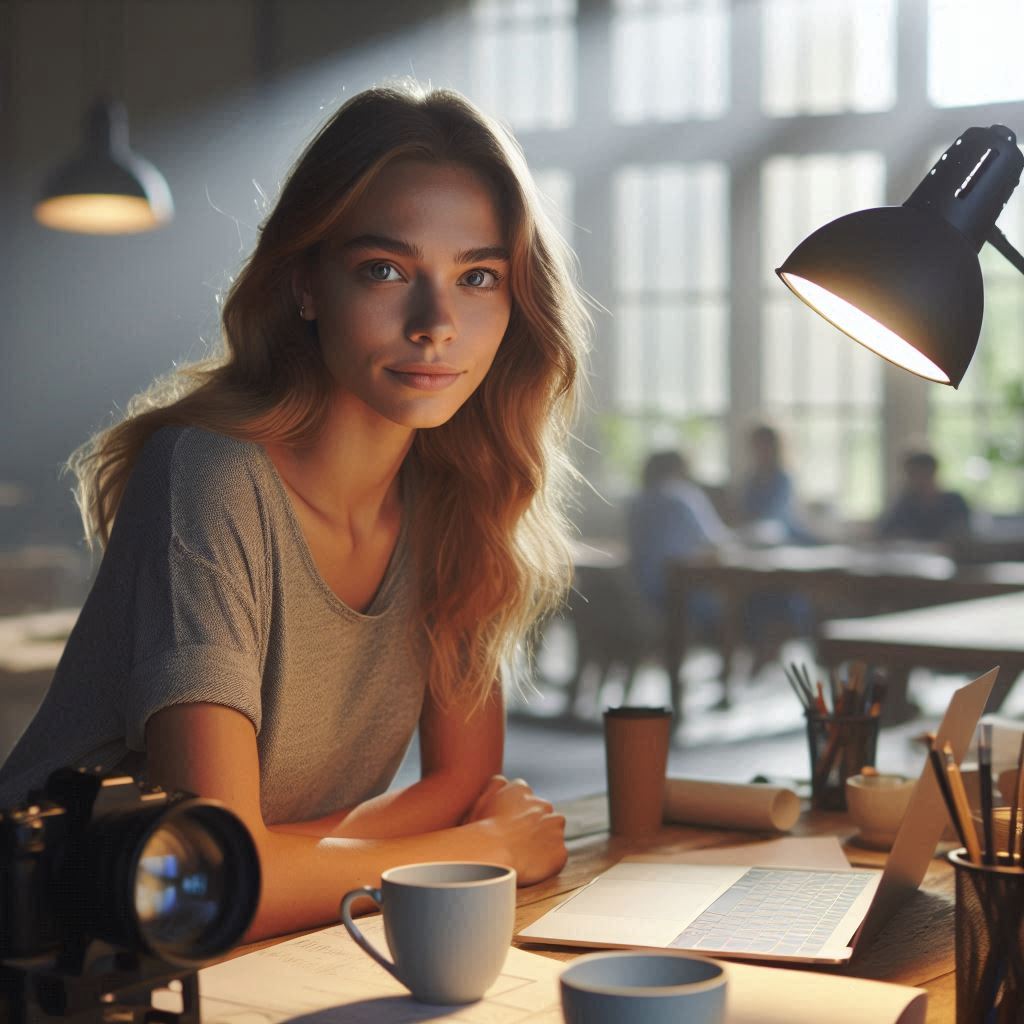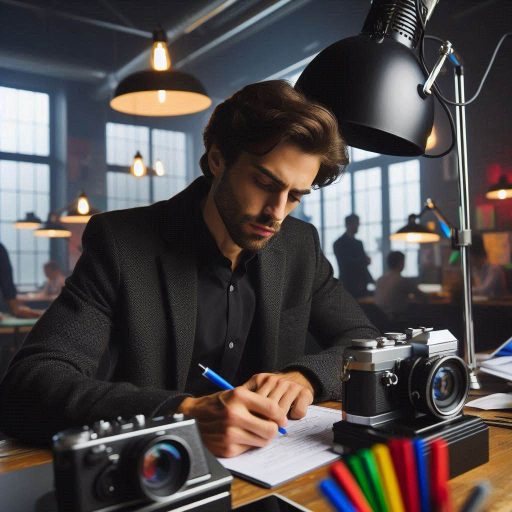Introduction
Lighting design plays a crucial role in film and TV production, as it sets the mood, highlights important elements, and creates a visually appealing atmosphere.
In this blog post, we will explore the key aspects of lighting design for film and TV, including the different types of lighting setups, techniques used by cinematographers, and the impact of lighting on storytelling.
Types of Lighting Setups
There are several types of lighting setups used in film and TV production, including three-point lighting, natural lighting, and high-key and low-key lighting.
Each setup serves a specific purpose in enhancing the visual aesthetic of a scene and conveying the desired mood or emotion.
Techniques Used by Cinematographers
Cinematographers utilize various techniques to achieve the desired lighting effects, such as backlighting, key lighting, and fill lighting.
Backlighting creates depth and dimension, key lighting emphasizes the main subject, and fill lighting balances out the shadows.
Combined, these techniques form a cohesive lighting design that enhances the overall visual appeal of the production.
Impact of Lighting on Storytelling
Lighting has a significant impact on storytelling in film and TV. The use of light and shadow can convey emotions, reveal character traits, and create a sense of tension or atmosphere.
By manipulating lighting, filmmakers can effectively communicate the narrative and engage the audience on a deeper level.
The Role of Lighting in Creating Mood and Atmosphere
Lighting plays a vital role in film and television.
It shapes how viewers feel about a scene. Different lighting techniques evoke specific emotions in the audience.
For example, bright, warm light creates a sense of happiness and comfort. In contrast, dim, cool lighting can induce feelings of sadness or tension.
How Different Lighting Techniques Can Evoke Specific Emotions in the Audience
Filmmakers often use high-key lighting to convey cheerful scenes.
This technique involves well-distributed light that reduces shadows.
For instance, the iconic caf‘ scene in Am‘lie uses high-key lighting.
The bright, warm tones create a whimsical atmosphere, enhancing the film‘s playful nature.
Viewers feel uplifted, immersing themselves in Am‘lie‘s joyful world.
Conversely, low-key lighting generates a mysterious or suspenseful mood.
This technique features strong contrasts between light and shadow.
A classic example is the film Blade Runner, where shadows dominate many scenes.
The dark, neon-lit cityscape creates a dystopian atmosphere.
This lighting choice evokes feelings of uncertainty and foreboding.
Viewers sense the dangers lurking in the shadows.
Soft lighting can also soften harsh realities, making scenes feel intimate.
Filmmakers often use this technique in romantic films.
In The Notebook, soft lighting bathes the couple in a warm glow.
This effect enhances their emotional connection, allowing viewers to feel their love.
The soft light creates an inviting atmosphere, drawing the audience into their world.
In horror films, lighting can heighten fear and anxiety.
Sudden flashes of light or flickering bulbs increase tension.
For example, the iconic scene in The Shining with the hallway lights builds suspense.
The stark contrasts and eerie shadows create an unsettling feeling.
Audiences hold their breath, anticipating what might happen next.
Examples of Iconic Scenes Where Lighting Played a Crucial Role in Setting the Tone
Silhouettes also play a significant role in establishing mood.
Filmmakers often use backlighting to create striking visual contrasts.
In Psycho, the famous shower scene employs strong backlighting.
The shadows emphasize the violence and horror of the moment.
This choice amplifies the emotional impact on viewers, making it unforgettable.
Color temperature in lighting further influences audience perception.
Warmer colors evoke feelings of comfort, while cooler colors create distance.
For instance, the film Moonlight utilizes warm hues during intimate moments.
This choice enhances the connection between characters, drawing viewers into their experiences.
In short, lighting profoundly affects mood and atmosphere in film and television.
Different techniques can evoke specific emotions, drawing viewers deeper into the story.
From high-key lighting‘s warmth to low-key lighting‘s tension, each choice shapes the narrative.
Iconic scenes showcase lighting‘s power to enhance storytelling, making it an essential tool for filmmakers.
Read: Networking Events for Costume Designers
Understanding the Basics of Lighting Design
Lighting design plays a crucial role in film and television. It sets the mood, enhances storytelling, and shapes the viewer’s perception.
To create effective lighting, one must understand key lighting terms: key light, fill light, and backlight.
Explanation of Key Lighting Terms Such as Key Light, Fill Light, and Backlight
The key light serves as the primary light source in a scene.
It casts strong shadows and highlights the subject’s features.
Positioning the key light at an angle creates a natural look.
The intensity and direction of the key light establish the overall mood.
It helps define the scene‘s tone, whether dramatic or uplifting.
Next, we have the fill light.
This light softens the shadows created by the key light.
It ensures that details in the darker areas remain visible.
The fill light has a lower intensity compared to the key light.
It can be placed directly opposite the key light to create balance.
By adjusting the fill light’s intensity, you can control how pronounced the shadows are.
A well-balanced fill light enhances the subject‘s visibility without overpowering the key light.
The backlight, also known as the rim light, adds depth to the scene.
It illuminates the subject from behind, creating a halo effect.
This effect separates the subject from the background.
The backlight enhances the three-dimensionality of the scene.
It helps viewers focus on the subject while still noticing the environment.
Proper placement of the backlight can create dramatic silhouettes or soft glows.
How These Different Lights Work Together to Create Depth and Dimension in a Scene
Combining these three lighting types creates a harmonious visual experience.
The key light sets the stage, the fill light softens the harshness, and the backlight adds dimension.
Together, they build a layered look that engages the audience.
Understanding how to manipulate these lights is essential for effective storytelling.
Filmmakers must consider the emotions they wish to convey.
Each light influences the atmosphere and can change the viewer’s reaction.
For instance, harsh lighting may evoke tension, while softer lighting can create intimacy.
Experimenting with the placement and intensity of each light source is crucial.
Filmmakers should strive for balance and cohesion in their lighting design.
The interaction between the key light, fill light, and backlight forms the visual backbone of any scene.
Mastering these fundamentals allows filmmakers to craft compelling narratives.
Lighting design is not just about visibility; it‘s about artistry.
Embracing these basics empowers creators to elevate their projects.
Read: Building a Portfolio for Costume Design
Types of Lighting Setups
Understanding the different types of lighting setups commonly used in film and TV is crucial for creating visually appealing and impactful scenes.
Here, we will explore two main types of lighting setups – three-point lighting and high key lighting – and when to use each based on the desired effect.
Three-Point Lighting
- Consists of a key light, fill light, and backlight to illuminate the subject from three different angles.
- The key light is the primary source of illumination, providing the most light on the subject.
- The fill light helps to fill in shadows created by the key light, reducing contrast on the subject.
- The backlight, also known as the hair light, separates the subject from the background and adds depth to the scene.
- Three-point lighting is versatile and commonly used in film and TV for its ability to create depth and dimension.
- It is suitable for creating dramatic and moody scenes, as well as highlighting specific elements within a frame.
- When to use three-point lighting: Ideal for interviews, narrative scenes, and any situation where the subject needs to stand out from the background.
High Key Lighting
- High key lighting is characterized by an overall bright and evenly lit scene with minimal shadows.
- It is achieved by using soft, diffused light sources to create a gentle, flattering illumination on the subject.
- High key lighting is often used in comedy, romance, and light-hearted scenes to convey a positive and upbeat mood.
- It can also be used to create a sense of openness and airiness in a scene, making it feel inviting and welcoming.
- When to use high key lighting: Perfect for creating a happy and uplifting atmosphere, as well as in product commercials and beauty shots.
- High key lighting can also be used to evoke a sense of nostalgia or to highlight the beauty of a subject without harsh shadows.
By understanding the differences between three-point lighting and high key lighting, you can effectively choose the right lighting setup to achieve the desired effect in your film and TV productions.
Experimenting with different lighting techniques can help you enhance the visual storytelling and captivate your audience with compelling cinematography.
Read: Visual Merchandiser: Job Market and Opportunities

Lighting Equipment and Tools
Lighting equipment is crucial for shaping the visual style and atmosphere of a film or TV production.
Cinematographers and lighting designers rely on various tools to achieve specific effects that enhance storytelling.
Introduction to Essential Lighting Equipment: Lights, Light Modifiers, and Color Gels
Lights, light modifiers, and color gels form the foundation of on-set lighting design.
Each type of light serves a distinct purpose.
Tungsten lights are traditional and produce a warm, indoor glow.
LED lights are more energy-efficient and versatile, suitable for various settings.
Fluorescent lights are soft, providing natural-looking light that works well in subtle scenes.
Light modifiers, such as softboxes, barn doors, and reflectors, offer more control over how light is distributed on set.
Softboxes soften light, reducing harsh shadows and creating a more even, diffused look.
Barn doors help shape and direct the light precisely, preventing unwanted spill.
Reflectors bounce light into darker areas, filling shadows naturally without adding more light sources.
Color gels are transparent filters placed over lights to alter their color.
These gels can simulate natural light conditions or evoke specific emotions.
For instance, a blue gel might simulate moonlight or a cold atmosphere, while red gels can introduce warmth or intensity.
How These Tools Are Used to Manipulate Light and Create Specific Effects on Set
Using these tools, filmmakers manipulate light to create a wide range of visual effects.
Different lighting setups can change the tone and emotional impact of a scene.
For example, using hard light without modifiers creates strong shadows and high contrast, which is often used for dramatic or suspenseful scenes.
On the other hand, soft light, created with diffusers or softboxes, adds a gentle, flattering glow, perfect for romantic or intimate moments.
Light direction also plays a significant role in shaping the look of a scene.
Barn doors or flags can block and direct light to focus attention on specific characters or areas.
By controlling the intensity and direction of light, cinematographers can highlight important visual details while leaving other parts in shadow.
Color gels allow filmmakers to further manipulate the mood.
By using a combination of light modifiers and gels, cinematographers create dynamic lighting setups that transform ordinary scenes into visually compelling moments.
Blue gels might suggest a night scene, while warmer tones can create a nostalgic or dreamlike atmosphere.
Read: Visual Merchandising: Best Practices for Beginners
Techniques for Achieving Different Lighting Effects
Tips and tricks for achieving common lighting effects, such as soft lighting, hard lighting, and dramatic lighting
When it comes to lighting design for film and TV, knowing how to achieve different lighting effects is crucial.
Here are some tips and tricks to help you master the art of lighting:
Transform Your Career Today
Unlock a personalized career strategy that drives real results. Get tailored advice and a roadmap designed just for you.
Start Now- Soft Lighting: To create soft lighting, use diffusers or bounce light off surfaces to reduce harsh shadows.
- Hard Lighting: For hard lighting, use direct light sources with no diffusion to create sharp, defined shadows.
- Dramatic Lighting: Achieve dramatic lighting by playing with light angles and intensities to create high contrast between light and shadows.
Experimenting with Lighting Angles and Intensity
One of the key aspects of achieving dynamic visuals is experimenting with lighting angles and intensity. Here’s how you can do it:
- Low Angles: Shooting from low angles can create a sense of power and dominance for your subject.
- High Angles: On the contrary, shooting from high angles can make your subject appear vulnerable or small.
- Side Lighting: Side lighting can add depth and dimension to your scene by creating shadows on one side of the subject.
- Backlighting: Backlighting is a great technique for creating silhouettes or adding a halo effect to your subject.
- Adjusting Intensity: By adjusting the intensity of your lights, you can control the mood and atmosphere of your scene.
Remember, mastering lighting effects takes practice and experimentation. Don’t be afraid to try new techniques and think outside the box to create stunning visuals for your film or TV project.
Collaborating with Cinematographers and Directors
Importance of collaboration with other film crew members to achieve a cohesive visual style
- Working closely with cinematographers and directors is crucial for creating a unified look for the film or TV project.
- Cinematographers are responsible for capturing the visual tone of the production, while directors oversee the overall creative direction.
- By collaborating with these key members of the film crew, lighting designers can ensure that their work aligns with the project’s aesthetic goals.
- Building a strong working relationship with cinematographers and directors can lead to a more cohesive and visually impactful final product.
How to communicate effectively with cinematographers and directors to understand their vision for the project
- Start by conducting thorough pre-production meetings where all creative team members can discuss their ideas and vision for the project.
- Listen attentively to the cinematographer and director’s insights and preferences regarding the visual style and mood they aim to achieve.
- Ask clarifying questions to ensure you fully understand their expectations and objectives for the lighting design of the project.
- Keep an open line of communication throughout the production process to address any changes or adjustments to the lighting scheme.
- Collaborate on mood boards, visual references, and lighting plots to visualize the desired look and feel of each scene.
- Be flexible and adaptable to feedback and be willing to make adjustments to the lighting design based on the cinematographer and director’s input.
- Regularly review lighting tests and rehearsals with the cinematographer and director to fine-tune the lighting setup and ensure it matches their vision.
- Strive to maintain a positive and collaborative attitude when working with cinematographers and directors, as teamwork is essential for achieving a successful end result.
- Remember that effective communication and collaboration with key film crew members are essential for creating a cohesive visual style that enhances the overall storytelling of the project.
Uncover the Details: How to Ace an Exhibition Design Interview
Problem-Solving in Lighting Design
As with any creative endeavor, lighting design for film and TV comes with its own set of challenges that require problem-solving skills.
Let’s take a look at some common challenges faced in lighting design and strategies for overcoming them:
Common Challenges Faced in Lighting Design
- Working with limited resources: Budget constraints can often limit the equipment and resources available for lighting design, requiring creative solutions.
- Challenging shooting locations: Some filming locations may present difficulties in terms of natural lighting or space constraints, making it challenging to achieve the desired lighting setup.
- Time constraints: Tight production schedules can put pressure on the lighting team to quickly set up and adjust lighting for optimal results.
- Technical issues: Electrical problems or malfunctioning equipment can disrupt the lighting design process and require troubleshooting on the spot.
Strategies for Overcoming These Obstacles
- Plan ahead: Thorough pre-production planning can help anticipate potential challenges and come up with solutions in advance.
- Maximize available resources: Make the most of the equipment and resources available by being resourceful and creative in your approach to lighting design.
- Adapt to the shooting location: Be flexible and willing to adjust your lighting setup to work with the constraints of the filming location.
- Collaborate with the team: Effective communication and collaboration with other crew members can help overcome challenges and find innovative solutions.
- Experiment and innovate: Don’t be afraid to try new techniques or experiment with unconventional lighting setups to achieve unique and high-quality results.
- Stay calm under pressure: In fast-paced production environments, it’s important to remain calm and focused when facing unexpected challenges.
By being proactive, adaptable, and creative in your approach to lighting design, you can overcome common challenges and still achieve high-quality lighting for film and TV productions.
Conclusion
Understanding lighting design for film and TV is essential for creating visually appealing and engaging content.
By mastering the fundamentals of lighting, filmmakers can effectively convey emotions, set the tone, and enhance the overall storytelling experience.
In this blog post, we covered key concepts such as the three-point lighting technique, color temperature, and the importance of shadows.
We also discussed how lighting can be used to create depth, texture, and mood in film and television productions.
As you continue to learn and experiment with lighting design in your own projects, remember to practice and observe how different lighting setups can change the look and feel of your scenes.
Don’t be afraid to try new techniques and think outside the box to achieve the desired effect.
Whether you’re a seasoned professional or just starting out, mastering lighting design is a continuous learning process.
Stay curious, stay creative, and keep pushing the boundaries of what is possible with light in film and TV.
[E-Books for Sale]
The Big Book of 500 High-Paying Jobs in America: Unlock Your Earning Potential
$19.99 • 500 High-Paying Jobs • 330 pages
Explore 500 high-paying jobs in America and learn how to boost your career, earn more, and achieve success!
See All 500 High-Paying Jobs of this E-Book
1001 Professions Without a Degree: High-Paying American Jobs You Can Start Now
$19.99 • 1001 Professions Without a Degree • 174 pages
Discover 1001 high-paying jobs without a degree! Unlock career tips, skills, and success strategies for just $19.99!




